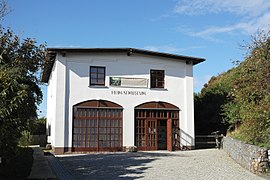Hiddensee Local History Museum
|
Hiddensee Local History Museum |
|
| Data | |
|---|---|
| place | Kloster auf Hiddensee, Kirchweg 1 |
| Art |
Local museum
|
| opening | 1954 |
| Website | |
| ISIL | DE-MUS-834615 |
The Hiddensee Local History Museum is one of the two museums of the monastery community on the island of Hiddensee , along with the Gerhart Hauptmann Museum . It is the local history museum of the entire island of Hiddensee and is run by a company owned by the municipality of Insel Hiddensee. It was opened in 1954 under the direction of Karl Ebbinghaus, two years before the Gerhart-Hauptmann-Haus . The specially founded Förderverein Heimatmuseum der Insel Hiddensee eV supports the work of the museum.
exhibition

The foundation for a collection of everyday objects in Hiddensee was laid by the locksmith Karl Ebbinghaus, who moved to the island from Westphalia . With the help of donations, after returning from the war , he acquired a sea rescue station built in 1888 on the upper beach of the village of Kloster and soon presented his exhibits and documents here to interested visitors. The collection was continuously expanded through further donations and a community of interests from Hiddense residents as well as through activities of the museum management; It consists of a permanent exhibition that shows the natural and cultural history of the island of Hiddensee and a small art exhibition that changes every year.
Fossils and the island's fauna are presented on the ground floor. A small area gives an insight into the sea rescue technology of earlier times. The amber is a separate small room reserved ( Amber Room ). The cultural history can be seen on the first floor of the museum. The main topics are:
- the early history of the island from the Neolithic to the Viking Age , u. a. with a replica of the Hiddensee gold jewelry , the original of which can be seen in the cultural history museum in Stralsund,
- the history of the monastery in the north of the island of Hiddensee, after which the district of Kloster is named today,
- fishing, in particular the tax and compulsory labor system during the period of serfdom,
- the organization of the fishing communities in "lots" and their drawing by the Utkaveln (drawing by small kavel stones, which were provided with house brands )
- the seafaring in relation to Hiddensee, u. a. using the example of the seaman Hugo Thürke, a Hiddenseer on a long voyage,
- the special tombstone culture on Hiddensee, which until well into the 20th century provided tombstones very cautiously, often only with the house brand of the deceased and the year of his death,
- the procurement of blue clay on Hiddensee in the 18th century for the Stralsund faience manufactory and
- shown the history of tourism from its inception until today. The focus is on the importance of Hiddensee as an artists' colony in the Empire and the Weimar Republic, the displacement of Jews from tourism during the Nazi era and tourism during the GDR era.
A small room on the ground floor is used for special exhibitions by Hiddensee artists.
location
The Hiddensee Local History Museum is housed in a former sea rescue shed. Coming from the road from the main town of the island, Vitte , it is on the left at the entrance to Kloster in Kirchweg 1. In front of the building there is a roundabout with flowers and bushes with a large anchor in the center. The explanatory panel shows that it was probably used as the reserve anchor for a Swedish 800–1000 ton sailing warship. In 1975 the fishermen Karl and Günter Kollwitz from Vitte pulled him out of the Baltic Sea. It was acquired in 1987 from donations from visitors to the Heimatmuseum and placed in front of it as an eye-catcher.
literature
- Wolfdietrich Eichler: Local history museum on Hiddensee in: Weltbühne. Wochenschrift für Politik, Kunst, Wirtschaft 9 (1954), pp. 1099–1103
- Information flyer from the Friends of the Heimatmuseum der Insel Hiddensee; As of 2013
Web links
Individual evidence
- ↑ Manfred Faust: Hiddensee - The story of an island , Ribnitz-Damgarten 2009, p. 382.
- ↑ a b c Hiddensee Culture: Formerly a sea emergency station - today a local museum , accessed on August 11, 2018.
